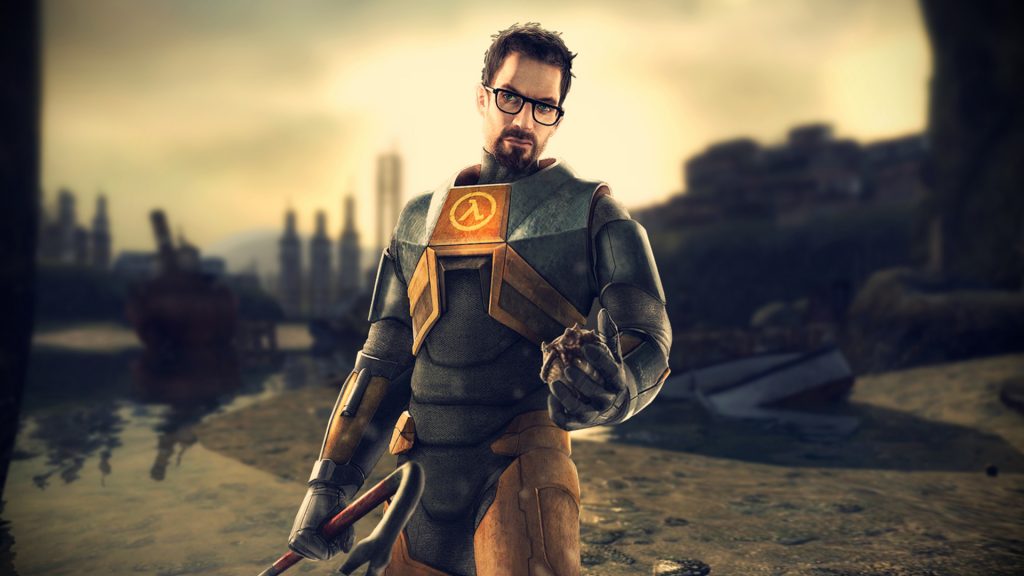Video Gamer is reader-supported. When you buy through links on our site, we may earn an affiliate commission. Prices subject to change. Learn more
At the heart of Half-Life, there is a battle of credentials. Who’s more mysterious? There’s the G-Man, who’s cut from the same pop-culture cloth as the Smoking Man, in The X-Files – a character whose menace was marked by the Morley dangling from his lips. In similar fashion, the G-Man is a walking collection of clues. A spook with eyes like ice, dressed in a sober suit, and with a crew cut issued by a Marine barber. Not quite of this world, he slithers between the folds of space and time, like an adder through the undergrowth. He also carries a briefcase – a prop traditionally reserved for bureaucrats and assassins. He might be both.
Then there’s the other G-Man, Gordon Freeman, whose secrets squirm free of our grasp. Everyone knows what he looks like – the goatee, the papery complexion, and the black-rimmed glasses – which is impressive, considering he never once appeared in Half-Life. Like his adversary, Freeman exists in different dimensions. To see his face, you have to look outside his world, to the same place you found Meryl’s codec frequency: the game case. Much is made of Metal Gear Solid’s parlour tricks, but where Kojima cracked the fourth wall with the subtlety of a crowbar, Half-Life hid Freeman under a box.
20 years down the line, in a week of wistful reflection, Freeman still eludes me. He’s the man that wasn’t there. In theory – which is where most of his life lies – he’s a physicist in the employ of Black Mesa, an organisation whose name describes the shape of its moral conscience. He goes to work in a research facility modelled on Area 51, and, as would only be right, conducts the sort of experiments those in tin foil hats have both feared and lusted for.

The first hour of Half-Life is, like the lunar surface, planted with several flags: one for each Iconic Video Game Moment. The tram ride. The gloomy bowels of the facility. The resonance cascade. The crow bar. The headcrab. But what the opening did so artfully wasn’t just propagate the story, the gameplay, and the next 18 years of first-person shooters; it scrambled Freeman’s circuitry, crossing his wires with contradiction. If he’s a nerd, how come he’s so handy with a Glock 17? If he never speaks, why is everyone at work so chatty with him? For someone who wouldn’t be caught dead in a cut scene, he sure seems fleshed out. What gives?
The answer, of course, is you. He can pummel a platoon of soldiers because you can, and you have the F5 key. And in your ambling exploration, details are offered like chocolates from a box. The baby picture in his locker. The detonation of his colleague’s microwave lunch – he’s a prankster! The running joke of his PhD being put to use with menial manual labour. And he never utters a word of complaint when the seams of our world come apart. What a dreamboat.
I’ve always shuddered when I’m informed that the best stories in games are the ones I ‘write myself.’ (It’s a grand old racket isn’t it? Perhaps J.K. Rowling should have released The Deathly Hallows blank, with a natty cover, and told children to use the wizardry of their imaginations to finish the saga.) But Half-Life stuffs its set pieces with enough props to make you feel as if you’re uncovering them, like a parent leading you to Easter Eggs planted in the garden.

There are some games that forcibly crutch their systems and worlds so that play nourishes the narrative of your character. Look at the Doomguy. Like Gordon, he says nothing; he is his armour and his gun. But the way that Doom demands to be played – the brazen burn of its Glory Kills that tug you back from the brink, with searing aggression as your saving grace – embroiders him with character. He is hostility with boots on, and he loves his job.
Then there are others whose worlds have such weight you find yourself bewitched. Take Red Dead Redemption 2, for example. Its opening is so lengthy and so marinated in emotion, up there in the mountains, that you find your freedom frost-bitten. Playing the thing makes me think like its hero, Arthur, might: I should have a bath, I should buy new clothes, I ought to bid good day to the trudging townsfolk.
Perhaps Gordon’s true spiritual sibling is Jack from Bioshock, who, instructed by Atlas to ‘kindly pick up a crowbar or something,’ winds up with a wrench instead. The breadth of Bioshock’s play meant that Jack could be the shutterbug, the hacker, or the heavy. As such, his story was bracketed by pre-rendered cutscenes, but his most memorable moment came with the swing of a golf club. The pageantry of Bioshock’s twist is infamous, but Gordon, years earlier – and with the swing of a crowbar, instead – made the same point. The impossibility of player agency took the form of an ironic joke: his surname.

Half-Life’s strange stew of freedom and detail, of absence and spectral presence, means we know enough about him to form an outline, and nothing more. It’s been twenty years since the first game, but the anniversary that haunts players is the 11 years since Half-Life 2: Episode Two. The prospect of a third episode grows dimmer by the day. It’s gaming’s Edwin Drood, its Sanditon. But even if we got what we’ve long clamoured for, I’m not convinced it would tell us anything more about Gordon Freeman. What more do we need to know?

